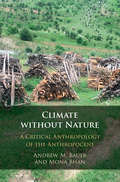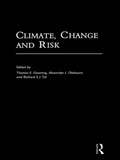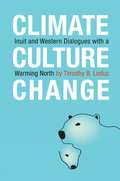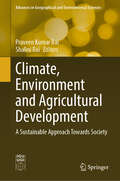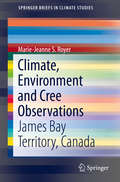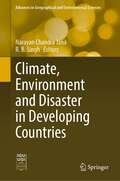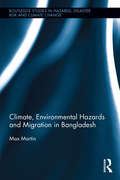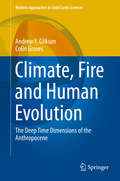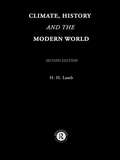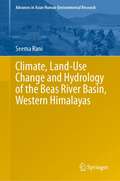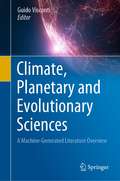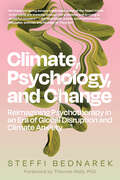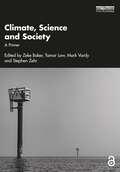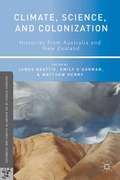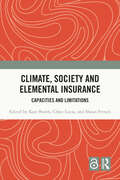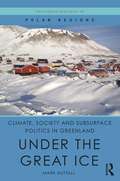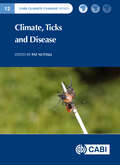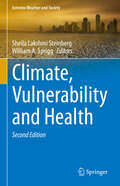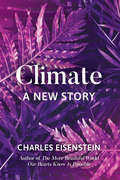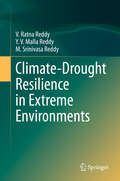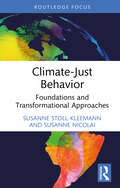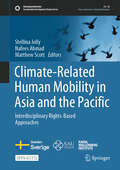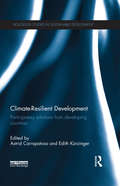- Table View
- List View
Climate without Nature: A Critical Anthropology Of The Anthropocene
by Andrew M. Bauer Mona BhanThis book offers a critical reading of the Anthropocene that draws on archaeological, ecological, geological, and ethnographic evidence to argue that the concept reproduces the modernist binary between society and nature, and forecloses a more inclusive politics around climate change. The authors challenge the divisions between humans as biological and geophysical agents that constitute the ontological foundations of the period. Building on contemporary critiques of capitalism, they examine different conceptions of human–environment relationships derived from anthropology to engage with the pressing problem of global warming.
Climate, Change and Risk
by Thomas E. Downing Alexander J. Olsthoorn Richard S.J. TolClimate, Change and Risk presents an overview of 'extreme' weather related events and our ability to cope with them. It focuses on society's responses, insurance matters and methodologies for the analysis of climatic hazards. Drawing on worldwide research from the leading names in the field this volume explores the changes in weather hazards that might be expected as the global climate changes.
Climate, Culture, Change: Inuit and Western Dialogues with a Warming North
by Timothy B. LeducEvery day brings new headlines about climate change as politicians debate how to respond, scientists offer new data, and skeptics critique the validity of the research. To step outside these scientific and political debates, Timothy Leduc engages with various Inuit understandings of northern climate change. What he learns is that today’s climate changes are not only affecting our environments, but also our cultures. By focusing on the changes currently occurring in the north, he highlights the challenges being posed to Western climate research, Canadian politics and traditional Inuit knowledge. Climate, Culture, Change sheds light on the cultural challenges posed by northern warming and proposes an intercultural response that is demonstrated by the blending of Inuit and Western perspectives.
Climate, Energy and Water
by Karen Hussey Pittock, Jamie and Hussey, Karen and Dovers, Stephen Jamie Pittock Stephen DoversWith the global population expected to reach nine billion by 2050, our capacity to provide enough food, water and energy relies on our understanding and management of the complex interdependencies in the climate-energy-water nexus. This book presents a comprehensive and up-to-date analysis of the interdependencies between these sectors and the knock-on consequences of those interactions for other sectors, such as food production and biodiversity conservation. The interdisciplinary nature of the book across the three sectors of climate, energy and water means that it will be valuable for advanced students, researchers and policymakers across a broad range of fields, including environmental/energy/water/climate policy, environmental economics, climate science, hydrology, ecology and geography.
Climate, Environment and Agricultural Development: A Sustainable Approach Towards Society (Advances in Geographical and Environmental Sciences)
by Praveen Kumar Rai Shalini RaiThis book discusses an emerging context of climate change, environmental degradation, monitoring and management, agricultural vulnerability and its development and adaptation from local to global scale. The book also describes the research methodology in a simple and lucid way so that a researcher can adopt it in his/her field studies. Individual chapters are dedicated to different subjects such as the quantification of climate change impacts on environment; land use land cover; crops in controlled and field conditions; water resources; soil fertility, erosion and carbon sequestration; insects, pests, weeds, microbes and diseases; greenhouse gas emission assessment; regional vulnerability to climate change; and selection of crop. Researchers from around the world and from various fields explore these important topics in the book. The book is a valuable resource for environmentalists, geographers, economists, agronomists, biologists, agricultural scientist, climate modellers, policyanalysts, development agency staff, and graduate and postgraduate students.
Climate, Environment and Cree Observations: James Bay Territory, Canada (SpringerBriefs in Climate Studies)
by Marie-Jeanne S. RoyerThis book examines the effects of climate and environmental change in the Eastern James Bay, Canada. This socio-environmentally oriented volume integrates scientific literature with the established ecological knowledge to explore current issues. This multidisciplinary approach allows for a broader understanding of the forces at play on the environment and the societies that inhabit it. It is suited to a wide range of readers from researchers and professionals working in the field to graduate students in climate change, geography, environmental science and ecology.
Climate, Environment and Disaster in Developing Countries (Advances in Geographical and Environmental Sciences)
by R. B. Singh Narayan Chandra JanaThe world is currently experiencing changes in climate and environment that often lead to natural disasters. Nearly three million people worldwide may have been killed in the past 20 years by natural disasters. In total, 90% of the natural disasters and 95% of all disaster-related deaths occur in the developing countries. Recently such problems have accelerated due to LULC change, biodiversity degradation, increased tourism, urbanization and climate change. This book, consisting of 27 chapters, explores the topics of climate, environment and natural disasters in developing countries. It is essential to discuss these diverse issues in the field of geography as it encompasses interdisciplinary topics. The range of issues on national, regional and local dimensions is not only confined to geography but also concerned to other disciplines as well. Therefore, this book is a valuable source for scientists and researchers in allied fields such as climatology, disaster management, environmental science, hydrology, agriculture, and land use studies, among other areas. Furthermore, this book can be of immense help to the planners and decision-makers engaged in dealing with the problems of climate, environmental change and natural disasters in developing countries.
Climate, Environmental Hazards and Migration in Bangladesh (Routledge Studies in Hazards, Disaster Risk and Climate Change)
by Max MartinThe apocalyptic visions of climate change that are projected in the media often involve extreme weather events, disasters and mass migration of poor people. This book takes a critical look at this notion, drawing on research in Bangladesh, a country located at the heart of debates on climate change and migration. This book argues that rather than leading to dramatic events, climatic and environmental impacts often cause incremental changes in people’s habitats and livelihoods, making them migrate in search of better places and income. With or without climate change, climatic and environmental factors can impoverish people, and drive displacement and migration, especially in the global South. These influences, including disasters, need not necessarily make people move, but instead sometimes trap the poorest and the most vulnerable people in their places exposed to hazards or make them migrate to even riskier places, such as crowded and flood-prone urban slums. This book argues that restrictions placed on people’s mobility options could increase their vulnerability and favours proactive migration policies. This timely contribution explains the climate-hazard-migration nexus in an accessible, engaging language for students of geography, development studies, politics and environmental studies, as well as humanitarian and development practitioners and policymakers.
Climate, Environmental Hazards and Migration in Bangladesh (Routledge Studies in Hazards, Disaster Risk and Climate Change)
by Max MartinThe apocalyptic visions of climate change that are projected in the media often involve extreme weather events, disasters and mass migration of poor people. This book takes a critical look at this notion, drawing on research in Bangladesh, a country located at the heart of debates on climate change and migration. This book argues that rather than leading to dramatic events, climatic and environmental impacts often cause incremental changes in people’s habitats and livelihoods, making them migrate in search of better places and income. With or without climate change, climatic and environmental factors can impoverish people, and drive displacement and migration, especially in the global South. These influences, including disasters, need not necessarily make people move, but instead sometimes trap the poorest and the most vulnerable people in their places exposed to hazards or make them migrate to even riskier places, such as crowded and flood-prone urban slums. This book argues that restrictions placed on people’s mobility options could increase their vulnerability and favours proactive migration policies. This timely contribution explains the climate-hazard-migration nexus in an accessible, engaging language for students of geography, development studies, politics and environmental studies, as well as humanitarian and development practitioners and policymakers.
Climate, Fire and Human Evolution: The Deep Time Dimensions of the Anthropocene (Modern Approaches in Solid Earth Sciences #10)
by Colin Groves Andrew Y. GliksonThe book outlines principal milestones in the evolution of the atmosphere, oceans and biosphere during the last 4 million years in relation with the evolution from primates to the genus Homo - which uniquely mastered the ignition and transfer of fire. The advent of land plants since about 420 million years ago ensued in flammable carbon-rich biosphere interfaced with an oxygen-rich atmosphere. Born on a flammable Earth surface, under increasingly unstable climates descending from the warmer Pliocene into the deepest ice ages of the Pleistocene, human survival depended on both--biological adaptations and cultural evolution, mastering fire as a necessity. This allowed the genus to increase entropy in nature by orders of magnitude. Gathered around camp fires during long nights for hundreds of thousandth of years, captivated by the flickering life-like dance of the flames, humans developed imagination, insights, cravings, fears, premonitions of death and thereby aspiration for immortality, omniscience, omnipotence and the concept of god. Inherent in pantheism was the reverence of the Earth, its rocks and its living creatures, contrasted by the subsequent rise of monotheistic sky-god creeds which regard Earth as but a corridor to heaven. Once the climate stabilized in the early Holocene, since about ~7000 years-ago production of excess food by Neolithic civilization along the Great River Valleys has allowed human imagination and dreams to express themselves through the construction of monuments to immortality. Further to burning large part of the forests, the discovery of combustion and exhumation of carbon from the Earth's hundreds of millions of years-old fossil biospheres set the stage for an anthropogenic oxidation event, affecting an abrupt shift in state of the atmosphere-ocean-cryosphere system. The consequent ongoing extinction equals the past five great mass extinctions of species--constituting a geological event horizon in the history of planet Earth.
Climate, History and the Modern World
by Hubert H. LambWe live in a world that is increasingly vulnerable to climatic shocks - affecting agriculture and industry, government and international trade, not to mention human health and happiness. Serious anxieties have been aroused by respected scientists warning of dire perils that could result from upsets of the climatic regime. In this internationally acclaimed book, Emeritus Professor Hubert Lamb examines what we know about climate, how the past record of climate can be reconstructed, the causes of climatic variation, and its impact on human affairs now and in the historical and prehistoric past. This 2nd Edition includes a new preface and postscript reviewing the wealth of literature to emerge in recent years, and discusses implications for a deeper understanding of the problems of future climatic fluctuations and forecasting.
Climate, Land-Use Change and Hydrology of the Beas River Basin, Western Himalayas (Advances in Asian Human-Environmental Research)
by Seema RaniThere is a need of strengthening the global and local response to cope with the threat of climate change and adverse effects of rising anthropogenic activities in the mountain ecosystem. This book provides an up-to-date and comprehensive scientific and technical knowledge based on climate and land cover change impact assessment, adaptation and mitigation strategies in the Indian Himalayan watershed. The text updates the understanding scientific analysis to promote evidence-based policy formulation at regional and local levels. It can be used as reference materials with regards to climate and land cover change for those new learners interested in the mountainous region. This comprehensive book covers a wide range of potential research areas including climate change scenarios, science and its applications, adaptation to climate change-theory and assessment, water resources, agriculture, forest, biodiversity, and ecosystems, indigenous knowledge etc.
Climate, Planetary and Evolutionary Sciences: A Machine-Generated Literature Overview
by Guido ViscontiThis book presents the result of an innovative challenge, to create a systematic literature overview driven by machine-generated content. Questions and related keywords were prepared for the machine to query, discover, collate and structure by Artificial Intelligence (AI) clustering. The AI-based approach seemed especially suitable to provide an innovative perspective as the topics are indeed both complex, interdisciplinary and multidisciplinary, for example, climate, planetary and evolution sciences. Springer Nature has published much on these topics in its journals over the years, so the challenge was for the machine to identify the most relevant content and present it in a structured way that the reader would find useful. The automatically generated literature summaries in this book are intended as a springboard to further discoverability. They are particularly useful to readers with limited time, looking to learn more about the subject quickly and especially if they are new to the topics. Springer Nature seeks to support anyone who needs a fast and effective start in their content discovery journey, from the undergraduate student exploring interdisciplinary content, to Master- or PhD-thesis developing research questions, to the practitioner seeking support materials, this book can serve as an inspiration, to name a few examples. It is important to us as a publisher to make the advances in technology easily accessible to our authors and find new ways of AI-based author services that allow human-machine interaction to generate readable, usable, collated, research content.
Climate, Psychology, and Change: Reimagining Psychotherapy in an Era of Global Disruption and Climate Anxiety
by Steffi BednarekWith so many immediate and intensifying crises unfolding around us, how can therapists adapt to promote healing and growth?&“As these intriguing essays make clear, some of the finest minds in the world are thinking through the problems and arriving at powerful answers."—Bill McKibben, author, environmentalist, educator, activist, and founder of Third ActWith essays from Francis Weller, Bayo Akomolafe, Hāweatea Holly Bryson, and moreWestern psychotherapy views our practice as a way to bring clients back to baseline &“normal.&” But our society&’s &“normal&” is profoundly unwell: our ways of being reflect the same unsustainable systems that erode our ecosystems, accelerate global destruction, and ultimately extract our humanity. Moving toward healing and purpose in uncertain times means evolving the way we do therapy and the way we think about mental health.Editor and climate psychologist Steffi Bednarek invites us to co-create a field that navigates unknown futures with skill and grace—one that helps clients build resilience and holds space for the uncertainties unfolding before us. She and 32 contributors explore ideas like:Decolonizing therapyUsing therapeutic tools to respond to traumaWhat psychologists can offer movements for social change and climate justiceHelping clients recognize and move past unhelpful responses to climate emergencyNurturing creativity in the face of crisisHolistic and intersectional, this collection reckons with the ways power, colonialism, and capitalism impact our myriad crises—while shaping Western psychology as we know it.With essays by clinicians from both the Global South and Global North, Climate, Psychology, and Change is an anthology unlike anything you&’ve read before: a necessary response, an urgent appeal, and a fearless look forward at how we care for our clients, eyes wide open, with compassion and skill in an uncertain world.
Climate, Science and Society: A Primer
by Zeke Baker Tamar Law Mark Vardy Stephen ZehrClimate, Science and Society: A Primer makes cutting-edge research on climate change accessible to student readers. The primer consists of 37 short chapters organized within 11 parts written by Science and Technology Studies (STS) and other social science scholars. It covers a range of key topics including communication, justice and inequality, climate policy, and energy transitions, situating each one within the context of STS studies. Each reading translates a focused area of climate change research into short, accessible, and lively prose. Chapter authors open debates where relevant, consider policy implications, critique existing areas of research, and otherwise situate their reading within a larger body of research relevant to climate change courses. Designed as a jumping-off point for further exploration, this innovative book will be essential reading for students studying climate change, STS, environmental sociology, and environmental sciences. The Open Access version of this book, available at www.taylorfrancis.com, has been made available under a Creative Commons Attribution-Non Commercial-No Derivatives 4.0 license.
Climate, Science, And Colonization
by Matthew Henry James Beattie Emily O’gormanOffering new historical understandings of human responses to climate and climate change, this cutting-edge volume explores the dynamic relationship between settlement, climate, and colonization, covering everything from the physical impact of climate on agriculture and land development to the development of "folk" and government meteorologies.
Climate, Society and Elemental Insurance: Capacities and Limitations
by Kate BoothIn this book, world-leading social scientists come together to provide original insights on the capacities and limitations of insurance in a changing world. Climate change is fundamentally changing the ways we insure, and the ways we think about insurance. This book moves beyond traditional economics and financial understandings of insurance to address the social and geopolitical dimensions of this powerful and pervasive part of contemporary life. Insurance shapes material and social realities, and is shaped by them in turn. The contributing authors of this book show how insurance constitutes and is constituted through the traditional elements of earth, water, air, fire, and the novel element of big data. The applied and theoretical insights presented through this novel elemental approach reveal that insurance is more dynamic, multifaceted, and spatially variegated than commonly imagined. This book is an authoritative source on the capacities and limitations of insurance. It is a go-to reference for researchers and students in the social sciences – particularly those with an interest in economics and finance, and how these intersect with geography, politics, and society. It is also relevant for those in the disaster, environmental, health, natural, and social sciences who are interested in the role of insurance in addressing risk, resilience, and adaptation.
Climate, Society and Subsurface Politics in Greenland: Under the Great Ice (Routledge Research in Polar Regions)
by Mark NuttallOnce imagined as a place on the very edge of the world, Greenland is now viewed as being at the epicentre of climate change. At the same time, international attention is focused on opportunities for oil and mineral development, seemingly made possible as the inland ice melts and sea ice disappears, revealing geological riches and making access to remote areas easier. In this book, Mark Nuttall takes the reader on a journey through landscapes, seascapes and icescapes of memory, movement and anticipation. Unravelling the entanglements of climate change, indigenous sovereignty and the politics surrounding non-renewable resource extraction, he describes how the country is on the verge of major environmental, political and social transformations as it aspires to greater autonomy and possible independence from Denmark. At the heart of this is discussion about how resources and the environment are given meaning and how they have become subject to intense political and ideological struggle. Climate, Society and Subsurface Politics in Greenland: Under the Great Ice is a key resource for academics, practitioners and students of anthropology, geography, development studies, political ecology and polar studies.
Climate, Ticks and Disease (CABI Climate Change Series #18)
by Charles Hart Peter Cox A. Townsend Peterson Nicholas Johnson Wei Liu Jianhong Wu Richard Wall Domenico Otranto Agustín Estrada-Peña Jeremy Gray Abdul Jabbar Jolyon M. Medlock Sunit Kumar Singh Giovanni Benelli Peter Irwin Richard Bishop Xue Zhang Hao Li DeMar Taylor Deborah Hemming Saeed Alasmari Neil Alexander Abdelghafar Alkishe Reiko Arai Armanda Bastos Gervasio Henrique Bechara John Beier Joshua Benoit Dennis Bente Adrien Blisnick René Bødker Fernando Boinas Sarah Bonnet Nathalie Boulanger Alejandro Cabezas-Cruz Alexandre Rodrigues Caetano Cyril Caminade Jirí Cerny´ Roxanne Albertha Charles Ali Reza Chavshin Rosalind Cornforth Neil Coughlan Lauren Culler Milan Daniel Vlasta Danielova Mona Dehhaghi Maria Diuk-Wasser James P Duffy Olivier Duron Lars Eisen Rebecca Eisen Jana Elsterová Koray Ergünay Li-Qun Fang Natalia Fernández-Ruiz Erol Fikrig Serhii Filatov Durland Fish Janet Foley José De Fuente Roman Ganta Aysen Gargili Keles Robin Beat Gasser Abdul Ghafar Naftaly Githaka Lucy Gilbert Maryna Golovchenko Yuval Gottlieb Ernest Gould Libor Grubhoffer Gilles J. Guillemin Kayleigh M. Hansford John E. Healy Stephen Higgs Andrew Hoodless Yan-Jang S. Huang Bernard Hudson Chris Huntingford Esther Kanduma Sirri Kar Maria Kazimirova Neil Kaye Thomas C. Kelly Lene Jung Kjaer Agatha Onyemowo Kolo Eduard Korenberg Nina Król Chi-Chien Kuo Timothy J. Kurtti Xavier De Lamballerie Patrick A. Leighton L. Robbin Lindsay Geoffrey E. Lynn Ilya Maclean Ben J. Mans Maristela Martins de Camargo Karen D. McCoy Ulrike G. Munderloh Atle Mysterud Sukanya Narasimhan Anna Obiegala Dasiel Obregón Alvarez Dr Nick H. Ogden Mari H. Ogihara Stefan Vilges Oliveira Charlotte Oskam Kennan J. Oyen Neha Pandey Hamed Kazemi Panahi John H. Pettersson Martin Pfeffer L. Paul Phipps Heather J. Plumpton Tatjana Pustahija Ram Raghavan Ryan O.M Rego Annapaola Rizzoli Isobel Ronai Franz Rubel Natalie Rudenko Benjamin Ruiwen Rufus Sage Abdallah M. Samy Gustavo Seron Sanches Isabel Kinney Santos Marcello Otake Sato Megumi Sato Richard Schloeffel Seyyed Javad Seyyed-Zadeh Ladislav Šimo Daniel E. Sonenshine Morgan Sparey Frederic Stachurski Snorre Stuen Matias Pablo Szabó Mike Teglas Sam R. III Saravanan Thangamani Georgia Titcomb Attila J. Trájer Michael Turell Rika Umemiya-Shirafuji Dana L. Vanlandingham Laurence Vial Margarita Villar André B. Wilke G. R. Wint Zbigniew ZajacThis book brings together expert opinions from scientists to consider the evidence for climate change and its impacts on ticks and tick-borne infections. It considers what is meant by 'climate change', how effective climate models are in relation to ecosystems, and provides predictions for changes in climate at global, regional and local scales relevant for ticks and tick-borne infections. It examines changes to tick distribution and the evidence that climate change is responsible. The effect of climate on the physiology and behaviour of ticks is stressed, including potentially critical impacts on the tick microbiome. Given that the notoriety of ticks derives from pathogens they transmit, the book considers whether changes in climate affect vector capacity. Ticks transmit a remarkable range of micro- and macro-parasites many of which are pathogens of humans and domesticated animals. The intimacy between a tick-borne agent and a tick vector means that any impacts of climate on a tick vector will impact tick-borne pathogens. Most obviously, such impacts will be apparent as changes in disease incidence and prevalence. The evidence that climate change is affecting diseases caused by tick-borne pathogens is considered, along with the potential to make robust predictions of future events. This book contains: Expert opinions and predictions. Global coverage of trends in ticks and disease. In-depth examination of climate change and tick distribution links. This book is suitable for researchers and students studying zoology, biological sciences, medical entomology, animal health, veterinary medicine, epidemiology, parasitology, and climate change impacts; and for those concerned with public health planning or livestock management where ticks and tick-borne pathogens pose a threat.
Climate, Vulnerability and Health (Extreme Weather and Society)
by Sheila Lakshmi Steinberg William A. SpriggThis contributed volume explores the intersection between climate change, vulnerable communities, and health. It includes a variety of case studies that highlight how changing physical and social environments impact the health of communities across geographies. The COVID-19 Pandemic and climate change together highlighted how social disparities and environmental inequalities in our society affect the health and well-being of people and places impacted by modern crises. This new volume, which appears in the book series Extreme Weather and Society, addresses the plight of socially vulnerable people and communities dealing with extreme weather and other latent and emerging risks. This book is meant for people who have an interest in climate change, extreme weather, and their impact on people and places around the world. Special focus is placed on the knowledge of local populations and the imperative to engage with people within the context their local culture, ethnicity, and geographies. The book is interdisciplinary and crosses the fields of geography, environmental studies, environmental science, climate science, environmental health, emergency management, environmental sociology, social work and public health among others. The book will appeal to anyone who studies, makes, or carries out social and environmental policy—especially to community leaders who must respond to health and environmental challenges within the context of social disparities.
Climate--A New Story
by Charles EisensteinFlipping the script on climate change, Eisenstein makes a case for a wholesale reimagining of the framing, tactics, and goals we employ in our journey to heal from ecological destruction With research and insight, Charles Eisenstein details how the quantification of the natural world leads to a lack of integration and our “fight” mentality. With an entire chapter unpacking the climate change denier’s point of view, he advocates for expanding our exclusive focus on carbon emissions to see the broader picture beyond our short-sighted and incomplete approach. The rivers, forests, and creatures of the natural and material world are sacred and valuable in their own right, not simply for carbon credits or preventing the extinction of one species versus another. After all, when you ask someone why they first became an environmentalist, they’re likely to point to the river they played in, the ocean they visited, the wild animals they observed, or the trees they climbed when they were a kid. This refocusing away from impending catastrophe and our inevitable doom cultivates meaningful emotional and psychological connections and provides real, actionable steps to caring for the earth. Freeing ourselves from a war mentality and seeing the bigger picture of how everything from prison reform to saving the whales can contribute to our planetary ecological health, we resist reflexive postures of solution and blame and reach toward the deep place where commitment lives.
Climate-Drought Resilience in Extreme Environments
by V. Ratna Reddy Y. V. Reddy M. Srinivasa ReddyThis book assesses the effectiveness of changes in watershed interventions in one of the most fragile resource regions of India. Specifically the chapters examine various watershed centred interventions and their implementation process. An evaluation of the livelihood impacts, including crop production on the communities, is discussed and an assessment of the drought and climate resilience of households in the context of watershed and related interventions, including institutions and capacity of the communities, is investigated. Lessons are drawn to further identify measures to strengthen and improvise interventions for enhanced climate-drought resilience in harsh environments.
Climate-Just Behavior: Foundations and Transformational Approaches (Routledge Focus on Environment and Sustainability)
by Susanne Stoll-Kleemann Susanne NicolaiThis book highlights the obstacles to and potential for a just transformation as a way out of the current climate crisis.This volume examines the barriers, opportunities and incentives around the pursuit of climate-just behavior, based on a comprehensive interdisciplinary and integrative analysis. It investigates how the gap between expressing concern about the climate crisis and giving it a high priority within the context of everyday behavior can be overcome. At the same time, it looks at the challenging politico-economic framework conditions such as the strong economic growth and profit orientation of capitalism. Although justice is a fundamental human motive, which should induce climate-just behavior, system justification is common and makes people rather justify their unjust behavior. In this book, a general and systemic framework on human behavior is provided, including internal factors, such as knowledge and psychological needs, external factors, such as socio-cultural and politico-economic factors, feedback loops and interactions. The authors draw on multiple theories to examine how denial and moral disengagement affect individual responsibility, despite real-world evidence of the climate crisis. The book highlights the role of emotions in encouraging a pro-environmental response and discusses solutions on both the individual and the collective level, such as transparency laws. Moreover, making climate-friendly options more accessible, affordable and convenient facilitates behavior change more effectively. Overall, this book presents knowledge-based, realistic approaches to surmounting these obstacles in order to achieve a more climate-just world.Climate-Just Behavior will be of great interest to students and scholars of climate change, climate justice, environmental geography and environmental psychology.
Climate-Related Human Mobility in Asia and the Pacific: Interdisciplinary Rights-Based Approaches (Sustainable Development Goals Series)
by Matthew Scott Stellina Jolly Nafees AhmadThis open access book critically examines the policies and practices related to climate-related human mobility in Asia-Pacific and the legal and policy protection framework for climatically displaced migrants (CDMs) through an interdisciplinary human rights-based approach. While covering the policy and theoretical dimensions of mobility, it also evaluates the issue through empirical studies. The book illustrates how interdisciplinary rights-based approaches address and identify gaps in the protection framework for the region regarding dimensions of climate change displacement, migration, forced migration, susceptibility to climate change, and typology of climate change-induced displacement. Presenting multiple case scenarios, it recommends a legal mechanism based on human rights in a region brimming with variety and multiculturalism. Bringing together voices from the Asia-Pacific Academic Network on Disaster Displacement, the book examines issues that are immediately relevant in countries where they are living and working. In addition to academic perspective, the chapters also bring perspectives from positions held in national human rights institutions and government. They bring insight into lived experience and policy processes, seeking to avert, minimize, and address displacement, including through general disaster risk reduction and climate change adaptation initiatives, as well as specific initiatives around emergency preparedness for response and planned relocation and resettlement. The chapters examine diverse forms of human mobility, including displacement, planned relocation, and forced immobility. The combination of studies focusing on both sudden onset and slower onset movement is also distinctive. With a thorough understanding of the interdisciplinary rights-based approaches to the issue, students, researchers, policymakers, administrators, and all those engaged in studying these topics can quickly evaluate and appreciate how the rights of CDMs are protected on a national, regional, and international level in Asia-Pacific.
Climate-Resilient Development: Participatory solutions from developing countries (Routledge Studies in Sustainable Development)
by Astrid Carrapatoso Edith KürzingerThe concept of resilience currently infuses policy debates and public discourse, and is promoted as a normative concept in climate policy making by governments, non-governmental organizations, and think-tanks. This book critically discusses climate-resilient development in the context of current deficiencies of multilateral climate management strategies and processes. It analyses innovative climate policy options at national, (inter-)regional, and local levels from a mainly Southern perspective, thus contributing to the topical debate on alternative climate governance and resilient development models. Case studies from Africa, Asia, and Latin America give a ground-level view of how ideas from resilience could be used to inform and guide more radical development and particularly how these ideas might help to rethink the notion of 'progress' in the light of environmental, social, economic, and cultural changes at multiple scales, from local to global. It integrates theory and practice with the aim of providing practical solutions to improve, complement, or, where necessary, reasonably bypass the UNFCCC process through a bottom-up approach which can effectively tap unused climate-resilient development potentials at the local, national, and regional levels. This innovative book gives students and researchers in environmental and development studies as well as policy makers and practitioners a valuable analysis of climate change mitigation and adaptation options in the absence of effective multilateral provisions.
